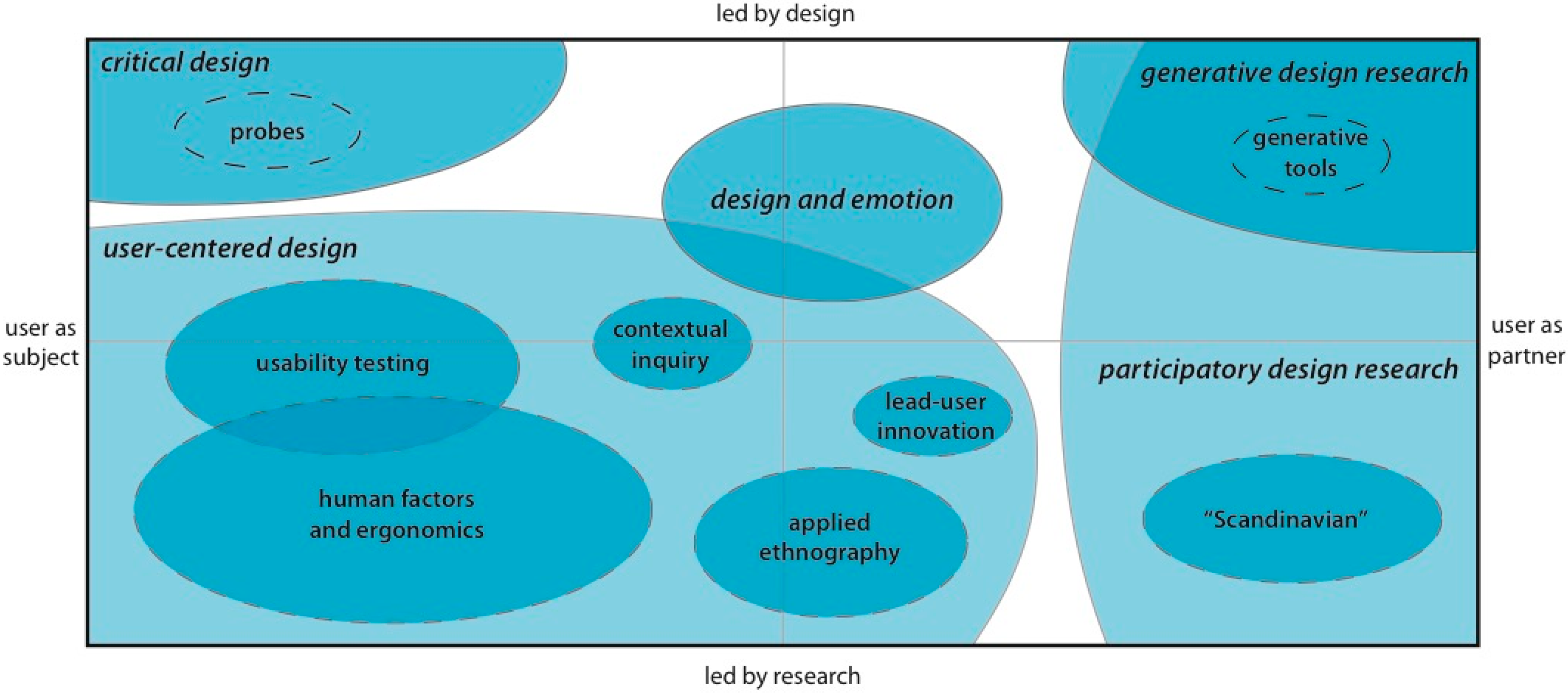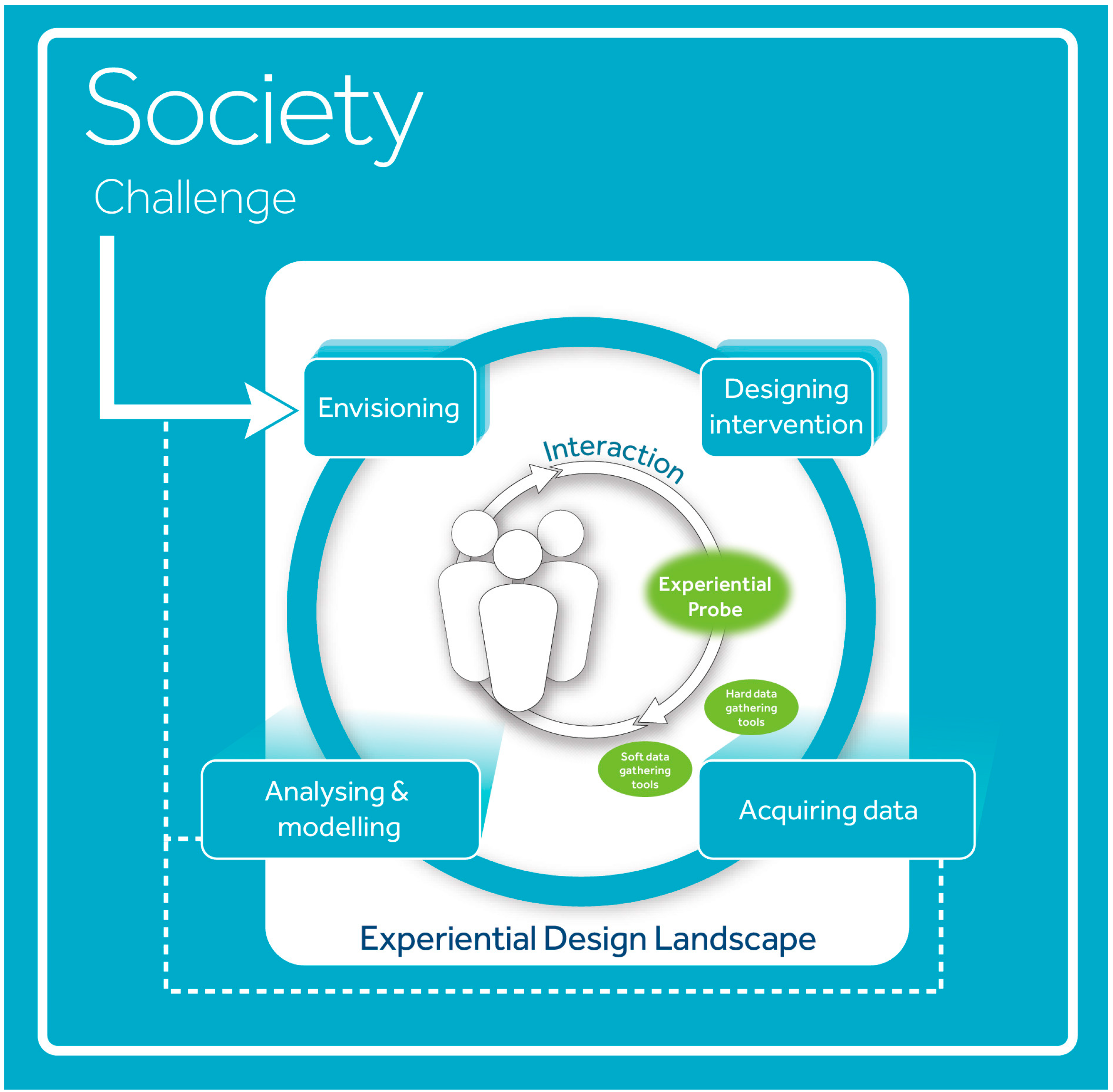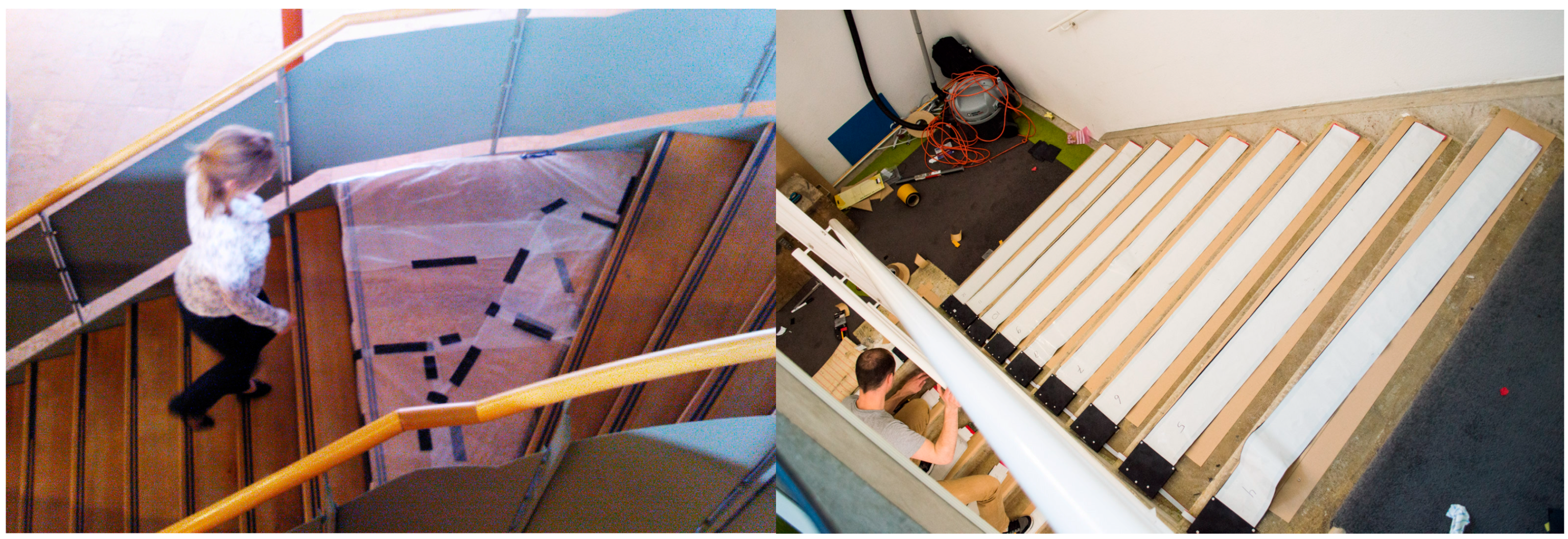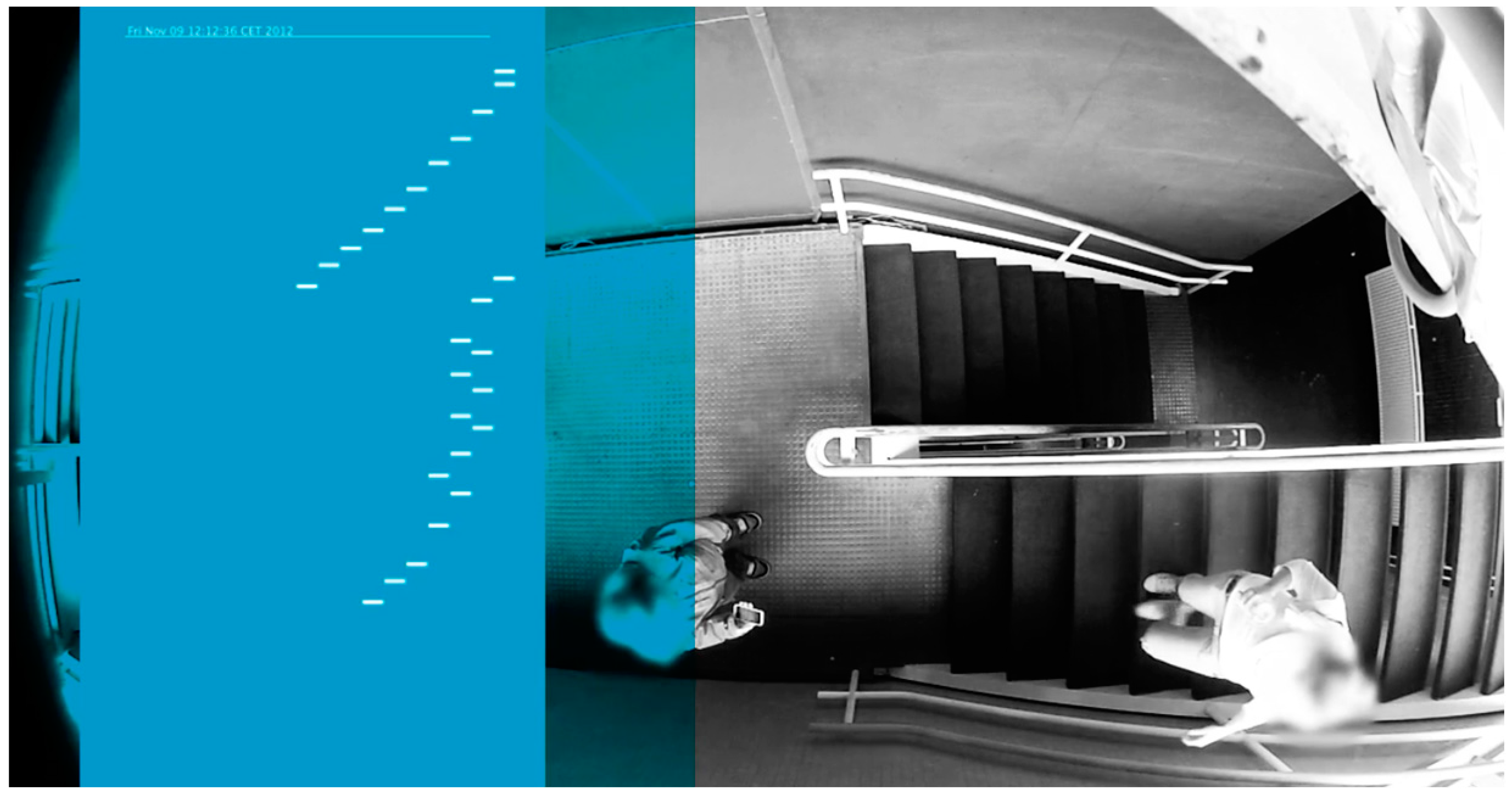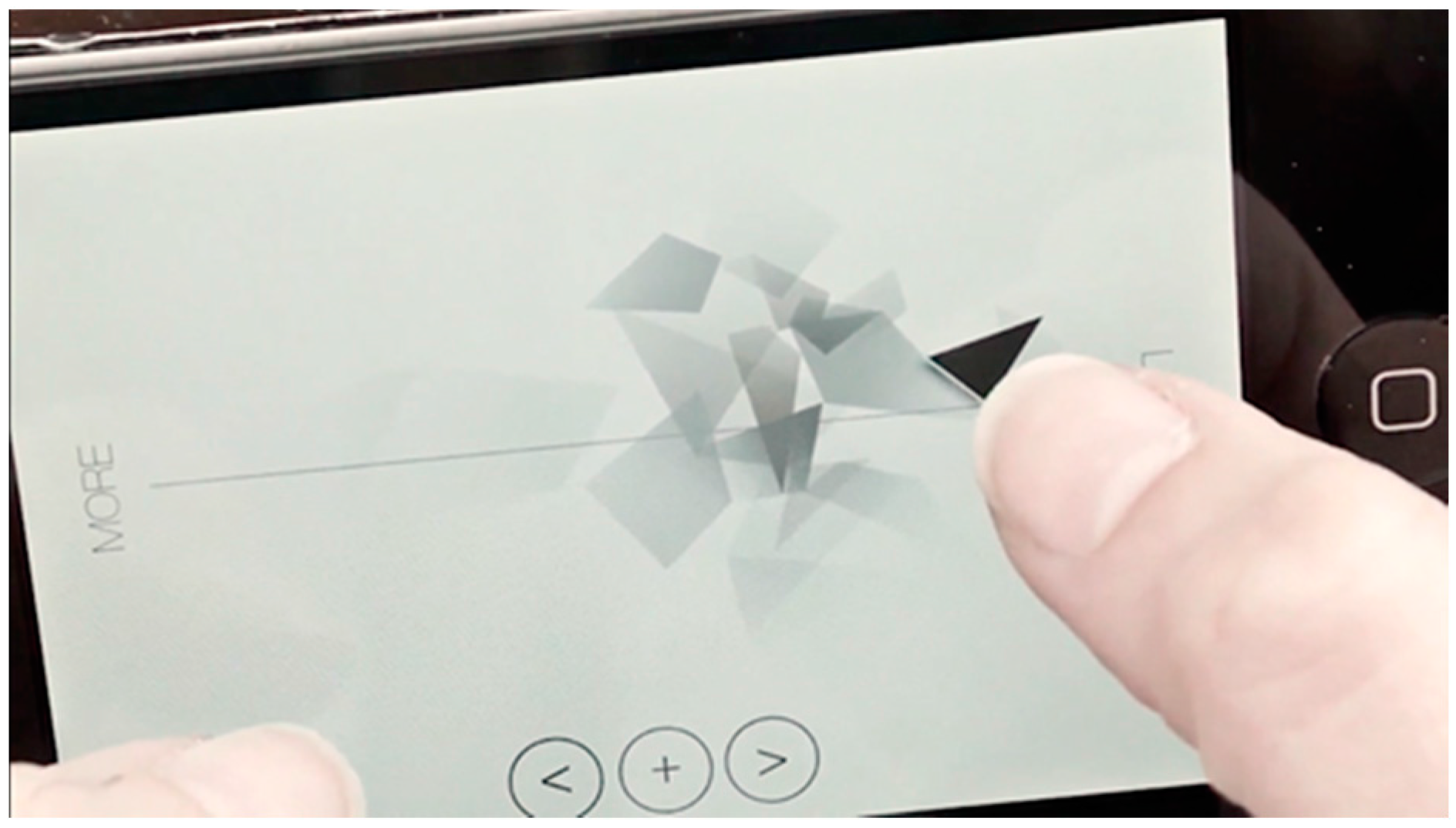The Experiential Design Landscapes (EDL) method is a design research method aimed at designing for and with people in their natural environment, to find ways to support them in structurally changing their behaviour on a local scale, and to address global societal issues in the long run. EDLs are environments, be it physical or virtual, that are part of society (e.g., designated areas in cities, sports parks, virtual platforms, etc.) in which a design research team meets people in their everyday lives. EDLs can be seen as a specific type of Living Lab or Field Lab. For the exact difference, please refer to the paper by Peeters et al. [
26]. The EDL method is society-aware, design-enabled and inspired. The EDL method is based on 4 process steps of envisioning, designing interventions, acquiring data, and analysing and validating this data [
25] (see
Figure 2).
The multistable interpretations, intentionalities and identities of the EP are not a result found after product launch, but can be explored, steered, challenged and radically changed during the design research process, based on people’s behaviour and the design research team’s vision of its future society. This creates a new process of design in which the design research team creates a dialogue through design with people in the EDL.
3.1. Social Stairs
Due to several causes, society is moving toward a sedentary and inactive lifestyle, with resulting consequences for the health and well-being of its citizens [
32]. One of these causes is the way our daily work has changed from physical to cognitive tasks, mostly performed in a stationary state. Work occupies a large part of our day and thus is of great influence on our lifestyle and health. Van der Ploeg et al. [
33] showed that sitting for more than eleven hours has such an effect on our health that exercising will not redress the damage caused by sitting this long. With the abovementioned in mind, we describe the first EDL, called Social Stairs, a design proposition for an intelligent staircase, installed in both the main buildings of the Eindhoven University of Technology and KPN, a Dutch landline and mobile telecommunications company.
On two flights of stairs, each stair detects footsteps and triggers sound accordingly. The stairs make sounds when a person walks up or down (and thus interacts with) the stairs. These interactions allow the design research team to offer a new stair-walking experience and to explore opportunities to get people using the stairs more frequently and differently. The Social Stairs aims at disrupting the usual way of transit between floors in the building. Over the course of time, different EP, i.e., various types of stair-walking experiences and accompanying soundscape designs, were developed based on this inspiration and vision of walking and playing in the Social Stairs EDL. These EP contained multiple layers of complexity and offered different sound experiences ranging from musical and rhythmical sounds to surprising sounds, echoes and even complete compositions. People could jointly explore and deepen the interaction with the Social Stairs (
Figure 4). Based on the behaviour and interaction of the people on/with the Social Stairs, each EP would react differently.
The Social Stairs EDL has been installed and carried out in the two separate locations where both EDLs ran for more than 6 months (
Figure 5). The initial version of the Social Stairs was a result of an educational master course, where students created the first explorative probe of an instrumented and interactive stairs in the Eindhoven University of Technology main building. The first quick and low fidelity probe consisted of applying bubble wrap to a staircase. The observed resulting emerging behaviour led to new cycles of the EDL, where each stair was provided with a sensor. Two iterations have been installed between the first and second floor, on one side of the staircase, giving people the option between the Social Stairs and a normal staircase. The second iteration was built for a duration of six months, during which 4 main different EP were developed, tested, experienced and iterated. The probes differed for the sounds they created, ranging from “bloomy” echoing soundscapes to staccato drum sounds. The design research team found the different probes to result in different kinds of emerging behaviour [
13]. This EDL in the main building lead to the interest of KPN to also have a Social Stairs EDL in their building, between the ground and first floor. Here a new and more robust Social Stairs was built, allowing the design research team to explore the Social Stairs concept in this new context and together with a business stakeholder.
The aim of the Social Stairs EDL was to explore ways to address the societal issue of increasing daily inactivity by being placed in an office environment. The designers wanted to find out whether they could get people working in an office environment to become more active, by both taking the stairs instead of the elevator, and increasing activity on the stairs. Although this will only lead to brief moments of physical activity during the day, it can show that designing such rich interactive environments in our sedentary environments can help to address the issue. For the designers to see whether people would change their behaviour and in what way, the Social Stairs EDL has been instrumented with sensors and cameras, to keep track of the behaviour patterns that would occur. The resulting data is again of great interest for the designers, as insights into possible emerging behaviour can further influence the design and design process towards the intended and envisioned goals.
When introducing the EP, the design team subsequently observes, interviews and questions the people in the EDL. This way, the design research team acquired data that helped in finding or addressing specific examples of behaviour and learning more about why people express this behaviour. By means of the EDL architecture the design research team could acquire multimodal data 24/7 on people’s possible changing or emergent behaviour on the Social Stairs. By saving the event logs of the steps, the design research team could keep track of which steps were taken (or not) by people and check if there were any interesting deviating behavioural patterns. Simultaneously, through the concealed miniature camera, the design research team could regularly check or real-time tap into the video to see what was going on in the Social Stairs. To gain a deeper understanding of why people were behaving in certain ways, interviews were held on the stairs as well (
Figure 6). Aside from these interviews, doing maintenance and iterations on the stairs also proved to be a valuable way of gaining more insight, as people on the stairs approached the design research to share their experiences and thoughts, resulting in a more natural and spur-of-the moment user participation. On the basis of these insights the design research team could take decisions on how to iterate the current EP, or come up with a new probe.
As an example, through some early experiential probing it was found that people would engage and invite each other to the stairs. This emergent behaviour was mirrored to the design research team’s initial vision on how to design for a more active and healthy society. Subsequently, this inspired them and sparked new ideas on designing different EP using louder and orchestral sounds that played with the social behaviour. Doing so would create new invitations and possibilities for behaviour on the stairs. The design research team did not predict the behaviour of people inviting other people to the stairs and playing with them together, but it did fit their vision even better on how to get people active.
Both the Social Stairs EDLs ran for over 6 months, resulting in a large dataset of recorded steps and timestamps. Through several iterations of data processing and visualisations a format was developed which allowed the design research team to see individual behaviour patterns in the data. By plotting steps over time in sequential rows the difference could be seen between “normal” stairs usage and new deviant behaviour patterns, showing new kinds of behaviour that non-instrumented stairs would not elicit. Normal stair usage would mean going up and down the stairs, hitting each (or every second) step in sequence, as can be seen in the top pattern in
Figure 7. With the Social Stairs EDL new behaviour patterns emerged where people would jump, skip and repeat steps instead of normal descending or ascending behaviour. An example of this can be seen in the bottom pattern in
Figure 7. Through plotting the data in this manner, the design research team was able to see human behaviour in detail, enabling them to appreciate the differences between normal and deviant behaviour patterns.
With over 60,000 use sessions in total the design research team found a wide range of different emergent behaviour patterns, ranging from jumping, dancing, skipping steps, trying to play a song, trying to mimic earlier patterns, etc. (
Figure 8). By constructing a set of rules to determine deviant behaviour patterns from normal behaviour patterns the design research team analysed a total of 60,000 use sessions (individual behaviour patterns). Using three of the different Experiential Probes they compared the deviant behaviour patterns, both on measured data such as measured steps and time as well as clustering on the visual characteristics of the data patterns. In this analysis they found a significant difference (
p < 0.05) between the steps and time of the use sessions of these three probes, showing a difference in the behaviour between the three different designs and their resulting emerging behaviour. Next, the team asked six fellow researchers to cluster individual use sessions on their similarities in appearance and related these clusters to the different probes through multidimensional scaling [
25], through which it became clear that the deviant stair use patterns of the EP themselves differed.
The design research found in this way of visualising the data, in combination with the recorded video, is a suitable way to find deviant behaviour patterns in the EDL. The data is therefore a good indicator for the design research team to see what happens in the EDL. The analysis, now done mostly by hand, has to be and can be automated to deal with these and larger quantities of data. Machine learning can here help in creating pattern recognition of the different types of deviant behaviour, as new types of behaviour constantly emerge. The interviews and user participation are however necessary to get an understanding why people are behaving the way they do.
Although we got an impression of the user behaviour in the EDL, the study also had drawbacks, mainly related to measuring behaviour change over time. Firstly, we didn’t perform a baseline measurement. This is due to the fact that the Social Stairs was set up as a design exploration at first, not as a research study. By exploring and building upon design ideas the Social Stairs EP was created and set out on the go, without first measuring a baseline for a few weeks. The designers didn’t know beforehand what the design would be about or that the Social Stairs would be the outcome. This highly explorative nature of the project led to the omission of a baseline measurement. The longitudinal aspect of the EDL method—the fact that Social Stairs was run for over several months—does help with creating an understanding of changes in time.
Secondly, we only measured the overall behaviour on the staircase to research if we could see different behaviour in people in relation to different behaviour/feedback on the stairs. But we did not have a set-up that enabled us to measure behaviour change on an individual level, let alone measure any long-lasting behaviour change. Our current research is moving in this direction. Our goal is to design and research systems, products and services in a way that would enable personal and social transformation. Our “design and theory for transformative qualities” aims to design and research qualities and beauty in materials and interaction, which can elevate (transform) personal/social ethics and related behaviour from an embodied interaction perspective. And with this transformation we mean long-term transformation. There are a multitude of studies that indicate, for example, the difficulty of long-lasting health-related behaviour change, such as stopping smoking, maintaining a healthy weight, or living a healthy life after a cardiac disease. As the complications of an unhealthy lifestyle are often deferred, especially with diseases such as diabetes, obesity and congestive heart failure, the motivation to adhere to therapy or a healthy lifestyle is often weak [
34].
Consequently, we are looking for designs that can enable users to tap into their intrinsic motivation and connect to their own values. Now that IoT is spreading and weaving into our everyday lives, and our environment and objects are becoming interactive and smart, designs such as Social Stairs will become more regular and affordable. Our challenge is not merely to entice transformation through design, which is already huge, but also how to measure this transformation. Consequently, we are further refining the EDL method and the Data-Enabled Design approach [
8] and hope to progress towards longitudinal, fully societally-embedded EDLs, in which technology enables personal and social transformation in a participatory data-enabled design process.
3.2. [Y]our Perspective
The second project we describe is [Y]our Perspective, which was developed within the larger “Light through Culture” educational project [
35,
36] lasting from 2011 to 2014. The project was promoted by the University of Siena, Eindhoven University of Technology and Interactive Institute Swedish ICT, Umeå. The aim of this educational project is to involve young designers (Bachelor’s, Master’s and Ph.D. students) in the development of innovative solutions for facing major social challenges of life today. The latest edition of the project was inspired by the political, economic and value-related crisis that is now affecting all of Europe. It aimed to explore how citizens can cope with the crisis and be engaged in envisioning the future of their cities. The project was developed in Siena (Italy), a city that has historically been accustomed to attributing to local communities (e.g., “contradas”; public associations) the role of promoting initiatives for safeguarding the organisation and the cultural and economical development of the territory. Unfortunately, the most important institutions in the city, which have historically supported the local community, are now experiencing a crisis that directly affects the forms of institutional arrangements, both public and private. This situation requires constant dialogue with citizens and a return to the participatory approach that characterised the life of the city in the past.
But how can citizens be actively involved in these new forms of dialogue? How is it possible to generate the right motivation, convincing citizens of the need for and importance of their participation in society? How can young people be encouraged to take part in politics, a world they now consider and perceive as some sort of parallel universe, far removed from the problems of everyday life? These are the questions the students of various disciplines (communication, design, engineering, political science) and different cultural backgrounds (Sweden, The Netherlands, Italy, Brazil, India) attempted to answer in a two-week course.
One of the design teams developed [Y]our Perspective, the design concept of an app allowing citizens and administrators to launch consultations regarding issues of public interest via smartphones. Polls are spatialised, that is, made accessible in the parts of the city involved in the consultation. For example, citizens who pass by the area where the stadium is to be built may launch a survey of people’s opinions on the advisability of building a stadium in the historical centre of the city (
Figure 9 left). When another person walks by the area where the stadium is to be built, the app sends the poll, in push mode (
Figure 9 right). The person receiving the notification may respond to the question posed while on the site, viewing the context.
Responses will be made available to the community, and participants will be able to state the reasons for their decisions. Responses to the poll are expressed in terms of value propositions, that is a statement of value that the person acknowledges. With the proposition, the person highlights the value or benefit that s/he would like to see and experience. Examples of value propositions are “ecology”, “carbon-free”, “hospitality” etc.
With reference to Marr’s [
7] 5 Vs of Big Data, [Y]our perspective tries to elicit mainly Variety and Value. The variety of data consists of the collection of geo-localised data, temporal data and qualitative data (topics of the pools). Value data consist of value proposition statements that highlight the personal interpretation and sense-making of people responding or proposing a poll. It is worth mentioning that the design of [Y]our perspective is conceived as a network of people gathering, but also proposing and making sense of information during the data collection. The mechanism is based on data sharing where the collection can originate from the municipality as well as from citizens. This opens up the possibility for a new dialogue between citizens and institutions.
The design of the app was driven by an investigation of different theories and methods of deliberative democracy carried out with experts’ assistance.
Bobbio [
37] identifies three levels of participation in democratic life. In the first level, participants merely listen to the technicians and administrators with the aim of formulating and assessing their contributions. With this approach, the administrators have the decision-making power in their hands. In the second level of participation, citizens become directly involved in the choice of plans, and are asked to debate a topic, contributing their own vision and offering the technicians an opportunity to work with the observations they have thus collected. In this case the influence of the recipients depends on the facilitator’s ability to bring out the participants’ demands and the ability to listen to the technicians and those promoting the process. At this level of interaction, it is still the technicians who hold the power to make decisions, and to decide whether to apply the participants’ suggestions. The third level is made up of citizens who play an active role in the process, working actively with the administration, possibly with the assistance of an external facilitator, to seek a solution to a problem considered to be everyone’s problem. In this case, the community plays an important and influential role, and is considered the key player in social change.
The third level includes decision-making, precisely because of the consideration and value placed on citizens’ proposals and active participation. In this model, citizens become involved right away, from the earliest phases of formation of a shared political conscience, including searching for and identifying the subsequent phases of reflection on the themes of the debate. Therefore, this model potentially offers a way to encourage citizens to cooperate in the search for solutions to social and political dilemmas, instigating active involvement which does not stop at the choice of people to represent them in political elections.
On the basis of this theoretical framework as well as interviews conducted with citizens on issues of common interest, and of the study of examples of good government taken from the history of the city of Siena, students developed a video concept that was used as the basis for participatory design sessions with Sienese citizens. The video is included in a larger video documentary available at [
38].
The design of the poll mechanism of the app was inspired by the “Conflict Spectrum”, a methodology used in deliberative democracy to solve conflicts at an early stage [
39]. The method allows people to understand the motivations of other people taking a certain position as well as the number of people sharing certain opinions. It requires that participants publicly express their point of view which is used only when people feel comfortable enough to take a stand openly. The method works like a bodystorming. Participants have to align themselves along a virtual line connecting two corners in the room. People who are firmly convinced of a certain position move to one corner. People who are convinced of the opposite move to the opposite corner. The participants are informed that infinite shades may exist between the two positions represented in the room by intermediate positions between the two corners. Each participant takes the position in the room corresponding to his/her view, and when people are placed along the spectrum, the facilitator asks them to briefly explain why they chose to get in that position. During the explanation, people are allowed to change their position in the spectrum toward a more convincing stand. If anyone chooses a new location, s/he is invited to explain why. The expected result is a better understanding of the personal opinion and that of the others, the acquisition of a more collaborative and open stand towards the opinion of others and hopefully the conflict resolution.
Inspired by this method, the graphical interface of the app was designed as a virtual conflict spectrum with opposite opinions placed at the extremes of a line (
Figure 10). The person responding to a poll can position her opinion along the line, expressing also the values or expected benefits from voting that position. He/she can also read other responses to the poll. These data are stored in the system and the results of the pool are dynamically visualised on a public large screen display in the city hall.
From the perspective of transformation, both empowerment and recognition of the other are strongly present in the design of this app. The spectrum empowers by offering virtual space for expressing the own voice, giving to the citizens a concrete, spatial frame of reference in which to locate their beliefs and points of view. It also creates an implicit sense of connection to the others: even those who stand at the opposite end of the spectrum stand in a continuum with the others. Also, cooperation with one‘s opponent in a joint activity dedicated to elucidating the views through value propositions in a positive and constructive way, creates a temporary ritual of common purpose.
[Y]our Perspective platform was designed through a number of participatory design activities that involved designers, students, experts in the field of political science, citizens and representatives of local public administration. The process did not however include any behavioural data sensing, mining or analysis with the actual prototype which served the purpose of consolidating the design concept rather than actually collecting data on the field through the platform.
However, participatory design sessions involved a large number of stakeholders (up to 150 as explained below) and highlighted a number of issues that clearly show the importance of a participatory approach to data-enabled design. First of all the interviewees stated that they would use the system only in the event that the municipality ensures that the measures discussed and approved by the citizens were actually placed on the political agenda. In this way, users would be strongly encouraged to contribute by using the app and feel they would want to continue to do so in the long term. In other words, gathering data without the chance to see it implemented was not seen to be worthwhile.
Yet it appears that the use of the app would be appreciated and spread if it turns out to be a social platform for communication and sharing, rather than a simple poll used by the municipality to monitor the citizenship’s opinions. People do not feel at ease generating data without taking part in the interpretation and implementation process. The fact that both parties (citizens and municipality) can propose a topic is a valuable point, because in this way the system would not be seen as a means for the public administration to achieve political consensus, but as a real attempt at communication and listening.
Another aspect expressed by almost all participants of the participatory design sessions is the importance of continuing the online discussions in public meetings with other citizens and local government representatives. A proposal should not halt at the level of exchanging views, but should result in subsequent collective deliberation, subject to the monopoly of the government on specific issues. This suggestion was elaborated a few months later in a follow-up project consisting in a large public consultation organised in Siena in the form of an Open Space Technology (OST) meeting involving around 150 participants (
Figure 11). Some of the themes discussed during the OST have been recognised as priorities in the political agenda of the municipality of Siena.
The OST served as a means to simulate the sense-making process that the app could stimulate on the basis of the data gathered on different pools.
